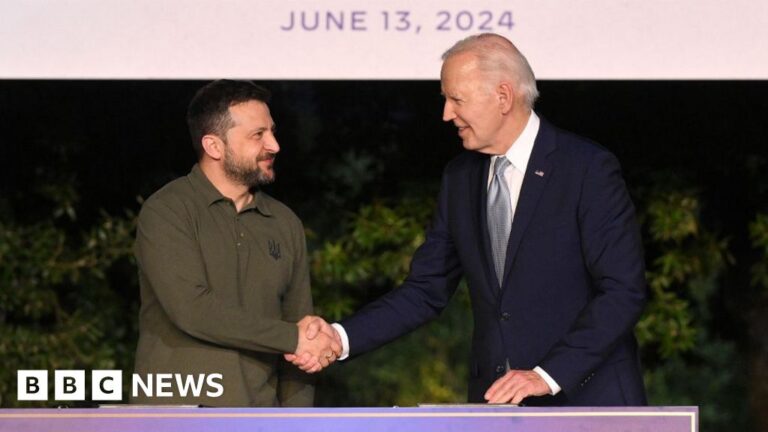By Jaroslav Lukiv, BBC News in London • John Mackenzie, BBC correspondent in Kyiv
The G7 agreed to use frozen Russian assets to raise $50bn (£39bn) for Ukraine to help it fight against invading Russian forces.
US President Joe Biden said it was another reminder to Russia “that we are not backing down”, but in Moscow, President Vladimir Putin said the move constituted “theft” that “does not would not go unpunished.”
Also at the G7 summit in Italy, Ukrainian President Volodymyr Zelensky and Mr Biden signed a 10-year bilateral security agreement between Ukraine and the United States, hailed by kyiv as “historic”.
The deal provides U.S. military aid and training aid to Ukraine – but it does not commit Washington to sending troops to fight for its ally.
According to the White House, the security agreement means that Washington and kyiv will work to build and maintain Ukraine’s defense and deterrence capability, strengthen the country’s defense industrial base, and support economic recovery and energy security.
The security agreement also means that in the event of a Russian armed attack on Ukraine, consultations will take place “at the highest levels to determine appropriate and necessary measures to support Ukraine and impose costs on Russia.” , adds the press release.
Separately, some $325 billion in assets have been frozen by the G7, alongside the EU, following Russia’s large-scale invasion of Ukraine in 2022. These assets generate around 3 billion dollars in interest per year.
Under the G7 plan, these $3 billion will be used to repay the annual interest on the $50 billion loan granted to Ukrainians on international markets.
The money is not expected to arrive until the end of the year but is seen as a longer-term solution to supporting Ukraine’s war effort and economy.
Speaking at a joint news conference at the summit site in Puglia, southern Italy, President Biden said the $50 billion loan would “put this money to work for Ukraine and would once again remind (Russian President Vladimir) Putin that we are not backing down.” “.
The American leader stressed that Mr. Putin “cannot wait for us, he cannot divide us, and we will stand with Ukraine until it prevails in this war.”
President Zelensky thanked his American and other allies for their continued support.
And referring to the new security agreement, he said: “This is a truly historic day and we have signed the strongest agreement between Ukraine and the United States since our independence (in 1991).”
The G7 group of rich countries, Canada, France, Germany, Italy, Japan, the United Kingdom and the United States, have been important financial and military supporters of Ukraine in its fight to contain the Russian occupying forces.
Other G7 leaders also welcomed the $50 billion loan deal, with British Prime Minister Rishi Sunak calling it a “game changer.”
The $50 billion loan represents a considerable amount of money, compared to US military aid worth $61 billion that was finally agreed in May.
A senior White House official said the fund agreed to by the G7 would have “multiple” uses, which could include “military support, budgetary support, humanitarian support, reconstruction support.”
There will be “flexibility in this structure”, added the American official, because some countries “prefer to send their money to budgetary support and reconstruction” while others will have funds “designated” for military support.
Some in kyiv, who were pushing for the money, wanted the G7 to release the entire frozen $300 billion fund, not just the interest it generates. The European Central Bank had ruled out this possibility.
The bank’s president, Christine Lagarde, previously warned that such a move risked “breaking the international order… that you would like Russia to respect.”
Unlike the U.S. aid program, which directly translated into more missiles being sent to the front lines, this money likely won’t arrive until the end of the year, which means that it will have little impact on the current course of the war.
For now, Ukraine says it still urgently needs more weapons – primarily air defense systems to mitigate Russian missile and drone attacks on its cities and power plants, as well as long-awaited F-16 fighter jets, which she hopes will begin arriving this summer.
At the G7 summit, Mr. Zelensky said the new security agreement provided for U.S. shipments of these fighter jets.
The loan agreement is also extremely symbolic for Ukraine. His attacker is now forced to pay, not only to repair the damage he caused, but also so that Ukraine can defend itself.
One of Mr Zelensky’s closest advisers said the West’s decision to punish Russia in this way marks, in some sense, a turning point in the war.
However, the loan is unlikely to force Russia to reverse its war in Ukraine.
Most of the frozen assets of the Central Bank of Russia are held in Belgium.
Under international law, countries cannot confiscate these assets from Russia and transfer them to Ukraine.
Speaking the day after the G7 decision was announced, President Putin promised that the decision “would not go unpunished.”
Moscow has said it interprets Western attempts to use money generated by freezing Russian assets as criminal action.
In February, Russia’s finance minister said the country had “ways to respond” if Western countries decided to seize Moscow’s funds.
European officials have previously said that European investors hold around 33 billion euros of funds blocked in Russia.


